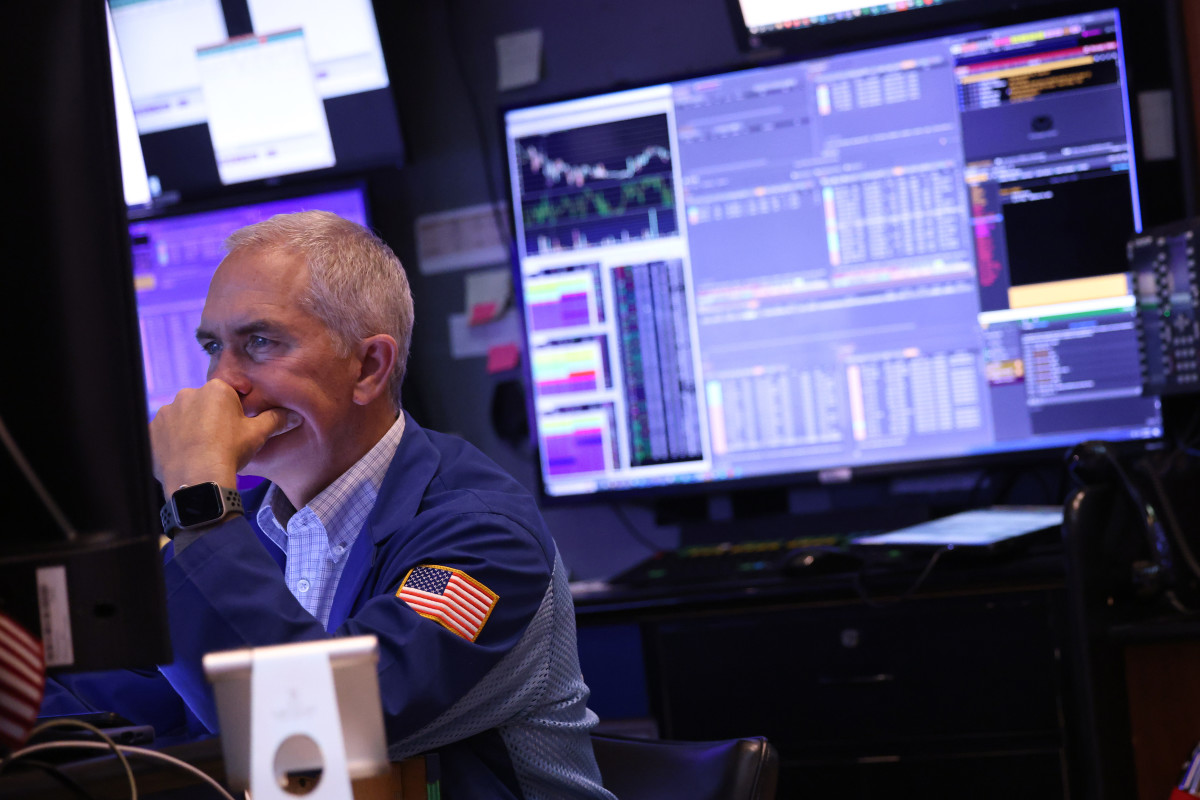
Global markets fell into a tailspin Monday, led by the biggest single-day decline for stocks in Japan since 1987, as investors pulled trillions from risk-asset markets amid concerns tied to U.S. recession fears, overpriced tech stocks and rising risks of a wider conflict in the Middle East.
The collection of risks across a host of asset classes is adding speed and depth to the global selloff, which is being worsened by thinner-than-usual volumes in the traditionally quieter month of August.
Below is a quick compendium of five of the most significant triggers to the selloff, which began last week and has lopped more than $1.3 trillion in value from U.S. stocks and dragged the tech-focused Nasdaq into correction territory.
1. The U.S. Federal Reserve's policy error
The Federal Reserve's decision to hold its benchmark lending rate steady at between 5.25% and 5.5% last week, the highest in more than two decades, is perhaps the most significant factor triggering the current selloff.
The Fed seemed reluctant to commit to a September interest-rate cut. Investors say that the central bank made a big policy error in keeping the Federal Funds Rate at these high levels for more than a year, even as inflation pressures continued to ease toward its 2% target and underlying weakness in the job market has become evident.
Related: Jobs report triggers key recession warning signal as stocks plunge
"In the first quarter of the year the market was debating whether the economy was overheating and reaccelerating, whereas during the second quarter focus shifted to whether things could be slowing too much, too quickly," said John Belton, portfolio manager at Gabelli Fund.
"Now there is concern that the Federal Reserve could again be 'behind the curve,'" he added.
The perfect storm hits market and what comes next. #Equity market update from @petergarnry https://t.co/U8zZYMjArX via @saxobank
— Ole S Hansen (@Ole_S_Hansen) August 5, 2024
Traders are now betting on an oversized 50 basis point rate cut when the Fed meets next month in Washington, with Wisdom Tree economist and Wharton School of Business Professor Jeremy Siegel calling for an emergency rate move before the Sept. 18 sit-down.
2. The yen-carry trade
Over the past two years U.S stock markets, and the tech sector in particular, have seen a huge rush of foreign investment power outsized gains for the three major benchmarks.
A notable portion of those gains, however, is tied to what is known as the yen-carry trade, a process in which investors borrow cheap money in Japan — at essentially zero interest — and reinvest it at higher rates in markets worldwide.
That trade, however, has been unwinding for weeks. And that move has accelerated over the past few trading days after the Bank of Japan executed two successive interest-rate hikes – its first in 17 years – and signaled a slowdown in the pace of its bond purchases in order to tamp down inflation pressures in the world's fourth-largest economy.
If you want to understand why the markets are collapsing, watch this video on the Yen Carry Trade. pic.twitter.com/73TBz0tAVt
— Aaron Levie 🇺🇸 (@levie) August 5, 2024
That's lifted the yen from a four-decade low of around 161.61 against the U.S. dollar last month to around 142.71 today. The 11% surge has traders racing to sell their overseas assets and convert them back into yen to stem some of their currency-related losses.
So far the moves seem to have been slightly overextended, leading to a correction during the European session, but the bias remains strongly to the downside in the short term, said Daniela Hathorn, senior market analyst at Capital.com.
3. Magnificent 7 reset
The market's five biggest tech stocks were responsible for the lion's share of the impressive 17% first-half rally in the S&P 500, with Nvidia (NVDA) , Microsoft (MSFT) and Apple (AAPL) jockeying for position as the world's most-valuable company.
That trade is starting to unwind as well, amid a July investor rotation from tech stocks into domestically focused companies that might benefit from both a second administration under former President Donald Trump and from bets on upcoming Fed interest-rate cuts.
Related: What Buffett's huge Apple sale really means
Muted near-term outlooks from Google (GOOGL) , Amazon (AMZN) , Apple and Microsoft during the second-quarter reporting season, as well as plans to increase capital spending over the second half, look to have accelerated that selling as well. Tech losses are leading declines in Asia trading this week and the Nasdaq slid into correction territory at the end of last week.
Bloomberg's Magnificent 7 Total Return Index, which was up 51% for the year as of July 10, has since fallen more than 18%.
News that billionaire investor Warren Buffett nearly halved his stake in Apple last quarter has added to concern that the sector is significantly overvalued.
"While we clearly get the worries/fears [that] the US consumer is weakening [Amazon consumer softer print, the] Fed is late to the game [and the] hard-landing bear thesis [is] returning, we focus on tech spending and the winners that will be front and center in this massive AI tech buildout that is still in the second inning of a nine-inning game," said Wedbush analyst Dan Ives.
4. Volatility in the market spikes
Another key factor in the current global selloff is the spike in Wall Street's so-called fear gauge, which is used to predict the levels of market volatility over the coming month.
The Chicago Board Options Exchange's VIX index, which traded near historic lows for much of the first half, has spiked to the highest levels since the depth of the Covid pandemic this week. That's triggered a rush out of riskier markets and into safe-haven assets such as U.S. Treasury bonds.
The VIX, which is calculated from stock-option prices, was last marked a staggering 167.5% higher on the session in early Monday trading and pegged at $49.73.
The perfect storm hits market and what comes next. #Equity market update from @petergarnry https://t.co/U8zZYMjArX via @saxobank
— Ole S Hansen (@Ole_S_Hansen) August 5, 2024
At that level, the VIX suggests that traders are expecting daily swings in the S&P 500 of around 3.1%, or 160 points, over the next 30 days. That's around three times the level of volatility markets were forecasting at the start of the second quarter.
"This past week of stock market volatility is overdue, as we are in the early stages of this bull market, which involve sharp rallies, like we saw so far this year, that are then punctured by sharp corrections, like we are now experiencing," said James Demmert, chief investment officer at New York-based Main Street Research.
"These corrections are healthy," resetting and normalizing stock prices and setting the market up "for another run to new highs," he added.
5. Geopolitical risks rise in the Mideast
Global oil prices have been weakening notably for the past month, with Brent crude futures contracts, the world benchmark, trading at the lowest levels since December.
While some of that decline is tied to concerns that slowing U.S. growth will trigger a slump in global oil demand, traders are also factoring in the prospect of a dangerously escalating conflict between Israel and Iran.
U.S. officials are urging Americans to leave Lebanon, and Israel is bracing for a possible retaliatory attack from Iran and Hezbollah following the killing of senior Hamas leader Ismail Haniyeh last week in Tehran.
The perfect storm hits market and what comes next. #Equity market update from @petergarnry https://t.co/U8zZYMjArX via @saxobank
— Ole S Hansen (@Ole_S_Hansen) August 5, 2024
“Reinforcing stability and security in the region will be achieved by punishing the aggressor and creating deterrence against Israel and its adventurism,” Nasser Kanaani, a spokesperson for Iran's Foreign Ministry, told reporters Monday.
“I reiterate and tell our enemies: We will respond and we will exact a heavy price for any act of aggression against us, from whatever quarter,” said Israeli Prime Minister Benjamin Netanyahu, according to the Times of Israel on Sunday.
The U.S. military, meanwhile, is upping its presence in the region even as government officials urge Netanyahu to advance cease-fire talks with Hamas.
Related: Veteran fund manager sees world of pain coming for stocks







